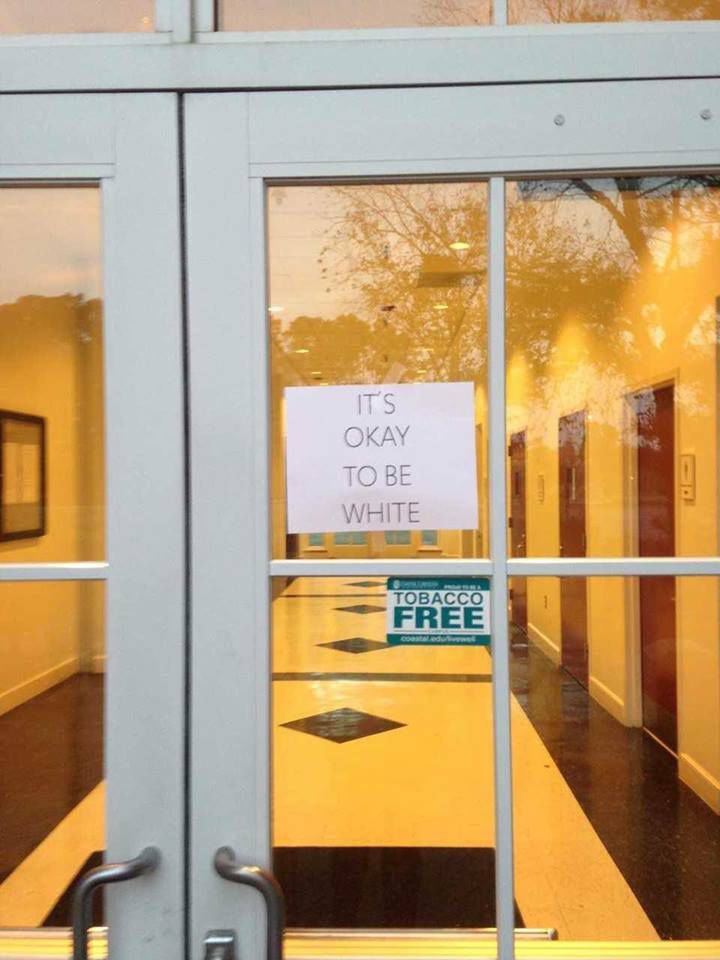White activists on the prowl. ‘It’s Okay to be White’ seems to be working. More below.
by Caitlin Byrd (843-937-5590 and follow her on Twitter @MaryCaitlinByrd.)

Hate groups in America went old-school with their recruitment efforts last year by plastering racist flyers on college campuses nationwide — a simplistic approach to attract a digitally savvy generation.
Experts say it could be working.
The annual “Year in Hate and Extremism” report from the Southern Poverty Law Center found there were roughly 300 incidents in 2017 where racist flyers were distributed on more than 200 college campuses across the U.S.
It happened at least three times in South Carolina.
In October, an alt-right recruitment flyer surfaced at Clemson University. The following month, signs proclaiming “IT’S OKAY TO BE WHITE” were found taped to doors on several buildings at Coastal Carolina University.
Weeks later, similar flyers appeared at the University of South Carolina.
It hasn’t slowed down. On the first day of the spring semester, two signs containing racial epithets appeared outside USC’s African American Studies Program.
Experts who follow the trend say that where hate-group recruitment efforts once found protections behind the anonymity of the internet, the current political climate since the election of President Donald Trump has emboldened them to be more in the open.
“This is no longer a movement defined by old cranky men who are plotting the return of ideology from 60 years ago,” said Ryan Lenz, a senior investigative writer at SPLC.
“The global wave of right-wing populism has a distinct youth component,” he said. “They want these ideas in a physical space.”
The college strategy
A college campus is not just any place. These institutions of higher learning are often known to embrace tolerance, diversity and multiculturalism — core ideas that hate groups fight against. At the same time, college students are intellectually curious and receptive to new ideas. Universities must also welcome free speech.
When an alt-right recruiting flyer appeared on Clemson’s campus, there was little the university could do since no threat to safety was made.
“As a public institution of higher learning, Clemson fully supports the right of free speech and strives to be a place where a wide range of ideas can be vigorously and respectfully debated,” said Mark Land, vice president for university relations.
“At the same time, the university is deeply committed to the safety of its students, employees and guests,” he added.
Being a forum for free and open expression of ideas made the appearance of racist signs inside a USC residence hall all the more challenging. Students demanded action. Lenz said a loud counter-response is exactly what these groups want.
“In this movement of younger racists, one of the things outside of recruitment is certainly focused on triggering,” Lenz said. “They know that if they put a poster in defense of the Confederate flag that liberals or left-wing students will be furious. Not only do they delight in that reaction, it galvanizes them.”
The SPLC numbers mirror a report by the Anti-Defamation League this month. It counted 147 incidents of white supremacist propaganda appearing on college and university campuses during the 2017 fall semester alone.
That’s a 258 percent increase over the 41 incidents during the fall semester of 2016.
Not exclusive to the South
Compared with other Southern states, South Carolina’s three reported racist flyer incidents on its college campuses was lower than the surrounding, but notably more populous, states. The report from the SPLC found Georgia had 10 incidents while both North Carolina and and Tennessee had six. Texas had 46.
The flyer efforts are not, however, exclusive to the South. California had 38 flyer incidents reported last year, according to the data.
John Dozier, USC’s associate provost and chief diversity officer, said he would not be surprised if it happens again.
“A lot of folks look at universities and think in some ways that we are divorced from society or society’s problems when, in fact, we are a microcosm of them,” he said.
Dozier suggests universities respond to these flyers by doing what they do best: educate. This week, USC unveiled a statue of Richard Greener, the school’s first African-American professor.
“We can give these students other physical reminders that provide a more complete narrative,” he said. “It’s something we can do if we don’t want to continue to repeat the challenges and mistakes of the past.”